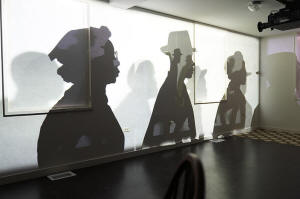Unique Chicago museum showcases the history of public housing through
its residents
[April 04, 2025]
CHICAGO (AP) — Set inside a once-dilapidated 1938 building on Chicago’s
near West Side, a one-of-a-kind museum hopes to change the perception of
public housing in America.
A former federal housing project that underwent a $17.5 million
transformation, the National Public Housing Museum opens Friday and
showcases recreated apartments from three different eras. It’s the
brainchild of public housing residents who wanted to tell a more
complete story about their lives, from the joys of living in tight-knit
communities to the effects of racist housing policies.
“The biggest artifact in our collection is the building itself,” said
Lisa Yun Lee, the museum’s executive director.
Remnants of a paint-chipped wall, with cracks and graffiti, greets
visitors at the entrance. Original mailboxes with apartment numbers
scrawled in marker are displayed near items belonging to Supreme Court
Justice Sonia Sotomayor, who grew up in New York public housing. An
outdoor garden is lined with decades-old animal statues, once the
centerpiece of a Chicago public housing courtyard.
Museum organizers hope to revive such a gathering place and say the
location in Chicago’s Little Italy neighborhood is important. The museum
complex includes 15 new public housing apartments where residents will
live. Next door is a city library branch that also has affordable
housing units. A mixed-income development is under construction nearby.
“It’s a museum that says, ‘There are things that everybody deserves,’”
said Sunny Fischer, a consultant for foundations, who grew up in public
housing and is the museum board's chair.
Museum admission is free though guided tours cost money.

The museum's opening faced delays, due to fundraising challenges and
different mayoral administrations with changing agendas. The building
was given to the museum by the federal Department of Housing and Urban
Development. The $17.5 million price tag is a mix of private donations,
including from foundations, and state and federal money.
Residents started planning the museum about 18 years ago as the nation’s
third-largest city was in the midst of demolishing public housing
high-rises. The ambitious and controversial improvement plan, which
displaced thousands of families, included tearing down Cabrini-Green, an
infamous housing project portrayed in the “Candyman” horror movies.
Residents didn’t want their stories to be wiped out with the towers.
Among the original planners was activist Francine Washington.
The 69-year-old has lived in Chicago public housing almost her entire
life. It’s where she raised a family and worked as a property manager
and in food service. She serves on the museum’s board and hopes to help
counteract stereotypes about public housing residents.
“Show them what we have accomplished, what we have done, what we have
been through,” she said. “Even though we’re in public housing, we’re
human beings. We want the same things in life that they want.”
[to top of second column]
|

A video projection by Manual Cinema uses animation, shadow puppets
and oral installation to help museum visitors "understand why more
than 50 years after the Fair Housing Act of 1968, we are still
living in a segregated world with a growing racial wealth gap,"
according to the National Public Housing Museum, Wednesday, March
19, 2025, in Chicago. (AP Photo/Erin Hooley)
 One of the museum’s goals is to show
how the racial makeup of public housing in Chicago and other places
changed, largely due to racist housing authority practices. For
instance, Black residents were concentrated in high-rises in
segregated communities with few opportunities to move.
The restored apartments inside the former Jane Addams Homes building
feature original artifacts donated by the families of former
residents, including clothing and dishes. The 1930s apartment
belonged to a Jewish family while one from the 1950s was an Italian
family's home. The third, from the 1970s, was the childhood home of
the Rev. Marshall Hatch, a well-known Black pastor and Chicago
activist.
Museum organizers say they also were inspired by New York City’s
Tenement Museum, which highlights preserved tenement apartments on
the Lower East Side. But Chicago organizers say they took it a step
further with a high-tech spin, including recorded oral histories
that play as visitors walk by, handheld screens and a video by a
shadow-puppet theater company that illustrates barriers Black
families faced in finding housing, like redlining.
At the same time, the museum showcases lesser-known bright spots in
public housing history, like resident-organized safety patrols and
cooperatives to sell groceries. Public housing residents called
“ambassadors” also work on museum staff.
“We had to change the narrative about public housing,” said Lee.
“When you said the words ‘Cabrini-Green’ that brought up a visceral
feeling in people. And usually that was one that was a stereotype of
what it means to be poor and Black in America. Creating exhibits
that challenge that narrative was a really important part of our
work.”
Perhaps the best example is the “REC Room,” a music studio where
visitors can scan albums from numerous genres to learn about
musicians who lived in public housing. That includes Elvis and
Salt-N-Pepa, whose group member DJ Spinderella lived in public
housing and is a museum curator.
A large black and white photo on the wall shows beaming residents
dancing at a Cabrini-Green house party.
It’s one of the favorite parts of the museum for Gentry Quinones, a
museum staff member who lives in Chicago public housing.
“There was also joy and community,” she said.
All contents © copyright 2025 Associated Press. All rights reserved
 |